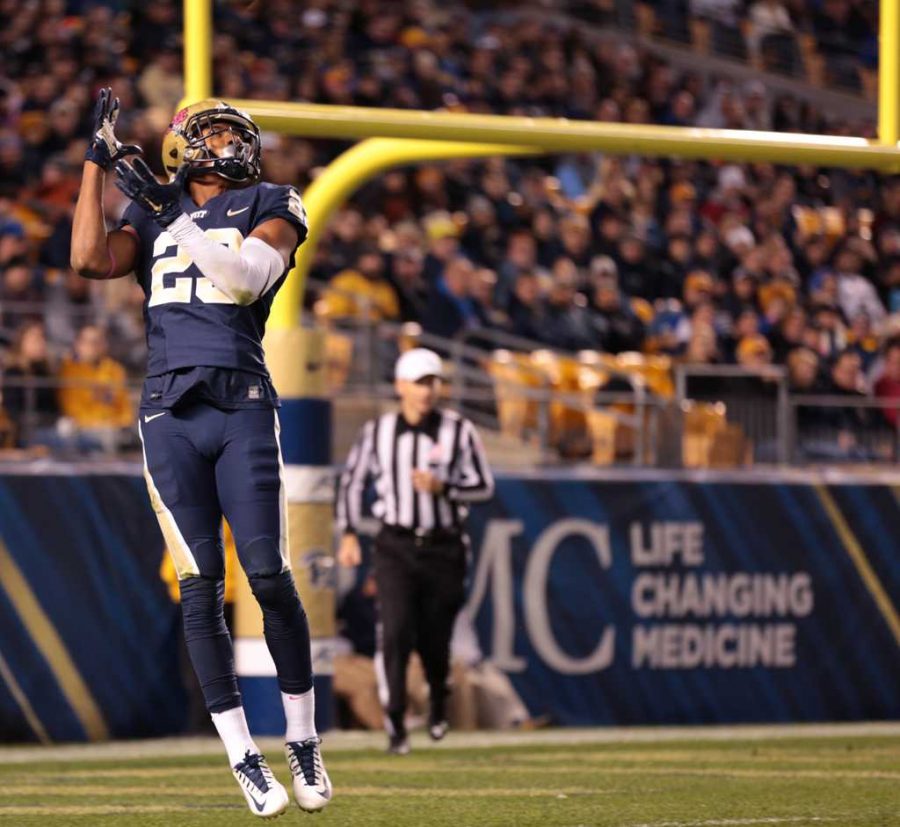When former Pitt wide receiver Tyler Boyd penned his farewell poem and left Pitt for the NFL draft, fans thanked the star wideout for his production.
As it turns out, Tyler Boyd will need to produce even more, as various draft scouts grade Boyd as a second- or third-round talent leading up to April’s NFL Draft.
Despite setting program records for career receptions and receiving yards and earning All-ACC marks in all three of his seasons at Pitt, it seems more likely than not that Boyd will have to wait until the second day of the draft to hear his name called.
While early on various sites had Boyd pegged as a potential first-round pick, his stock has slipped a bit due to increased scrutiny of his game tape, as well as a deep wide receiver draft class that includes University of Mississippi’s Laquon Treadwell, Ohio State’s Michael Thomas, Notre Dame’s Will Fuller and Texas Christian University’s Josh Doctson.
Like many prospects, scouts see different strengths in Boyd. Among his most apparent traits is his ability to run precise routes.
“Boyd has very good speed in his routes,” Matt Miller, lead NFL Draft writer at Bleacher Report, said. “But his ability to break off his routes at high speed and create separation is what separates him from other receivers in this class.”
In his most recent Big Board, Miller listed Boyd as his 38th-best player in the class, as well as his fifth-best wide receiver and top route runner.
While highlighting Boyd’s running precision, CBS Sports’ NFL Draft writer Dane Brugler noted that Boyd’s greatest strength might not be his feet, but his hands.
“This might sound simplistic, but Boyd’s best strength is his ability to catch the ball,” Brugler said. “A lot of wide receivers’ best strengths are their size or athleticism, but for Boyd, it’s his ability to pluck the ball with strong hands, using quick eyes and terrific sense of surroundings.”
Not everyone is as sold on Boyd. While agreeing that Boyd’s best traits are his routes and his hands, Pro Football Focus writer Steve Palazzolo noted that none of his abilities are elite enough to warrant early consideration.
“I’m not sure he does anything special, not enough that you’d take him in the first round,” Palazzolo said.
Palazzolo noted that he sees Boyd, who finished second in the ACC in receptions and receiving yards this year, as a second- to third-round pick.
Boyd has some weaknesses too — primarily, his build. At 6-foot-2-inches, 185 pounds, his frame could be an issue for some teams, as NFL cornerbacks are bigger and more physical than most of their college counterparts.
“His top weakness is his underwhelming size,” Brugler said. “He has lean body features and limited functional strength to break tackles or take consistent punishment in the NFL.”
Miller mentioned Boyd’s frame as a potential issue for some teams, noting that it’s something Boyd should try to work on in the pre-draft process.
“I’d like to see him add some weight while staying in the 4.4 to 4.5 second range [for his 40-yard dash time],” Miller said.
Boyd’s 40-yard dash time will be critical, as speed is obviously valued at the wideout position. According to Palazzolo, this area is where Boyd can improve his stock most.
“I think if he somehow ran under 4.4, it would certainly turn a lot of heads,” Palazzolo said.
When looking at a fit for a specific team, Brugler and Palazzolo didn’t think a style of offense was significant for Boyd.
“At this point, most NFL teams’ passing schemes are pretty much the same,” Palazzolo said.
But Miller was able to list some specific teams where the wideout’s talents would fit in.
“I’d love to see him in a situation like New Orleans or St. Louis, where he can be the outside receiver in an offense that values yards after catch,” Miller said. “The ideal spot is New England, but they’ve not valued receivers early in the draft.”
Analysts have compared Boyd to various current NFL players, and Miller, Brugler and Palazzolo all provided different, but similar players. Brugler said Boyd reminded him of the Dolphins’ Jarvis Landry. Miller said he was “in the mold of” Broncos wideout Emmanuel Sanders, while Palazzolo compared him to the Giants’ Victor Cruz when he was in his prime.
Even though Boyd isn’t projected to go in the first round, his decision to enter the NFL Draft a year early was still sound, according to Palazzolo.
“Would another year of college weight training help him? I don’t know,” he said. “I think that if you’re in that second- to third-round range, [entering the draft] is usually a good move.”


